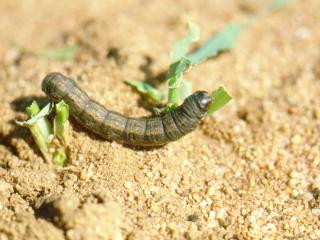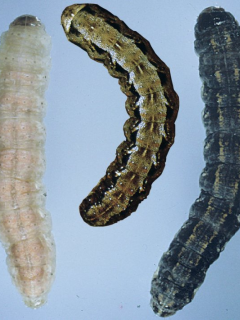Cutworm caterpillars can cut crop and pasture plants off at ground level
- Gunyidi
- Eganu
- Badgingarra
- Dandaragan
- New Norcia
Helen Lathlain (Nutrien Ag Solutions) reports finding widespread damage from cutworm in pastures in at Badgingarra and Dandaragan. In a self-sown pasture, north of Badgingarra 30% of the paddock is bare due to cutworm damage. The cutworms are at growth stage 4-5 instar, so should be pupating soon, but 2-3rd instar cutworms are also present. The pasture will be sprayed before being sown. There appeared to be more than one species of cutworm present in the paddock. The high numbers are likely the result of widespread rains in February and March.
Agworld users have also reported finding cutworms in wheat near New Norcia and barley crops near Gunyidi and Eganu.
Cutworm caterpillars are up to 50mm long, hairless with a dark head.
There are 3 main species. Caterpillars with a pink tinge belong to the pink cutworm, Agrotis munda, which has caused widespread damage in agricultural areas north of Perth. The dark grey caterpillars of the bogong moth, Agrotis infusa, have been extremely damaging in most parts of the agricultural areas from time to time. Large numbers of patterned caterpillars belonging to different genera, Rictonis and Omphaletis, have also been found attacking cereals in agricultural areas.
The caterpillars hide in the soil during the day, often at the base of lopped plants or edge of the damaged patch.
Cutworm caterpillars feed at or near ground level on all crop and pasture plants and are given their name because they often chew through leaves or stems giving a cut-off appearance. Similar to armyworm caterpillars, cutworm caterpillars are more likely to come into contact with insecticides applied in the late evening when caterpillars are actively feeding.
Cutworm moths can fly large distances and favour bare or lightly vegetated areas for egg laying.
For more information refer to DPIRD’s Diagnosing cutworm in cereals and Cutworm: pests of crops and pastures pages.
Cutworm caterpillars are usually easily controlled with registered rates of synthetic pyrethroid chemicals. For a list of insecticides registered see DPIRD’s 2020 Autumn winter insecticide spray guide.
For more information contact Svetlana Micic, Research scientist, Albany on +61 (0)8 9892 8591 or Alan Lord, Technical officer, South Perth on +61 (0)8 9368 3758.
Article author: Cindy Webster (DPIRD Narrogin).


